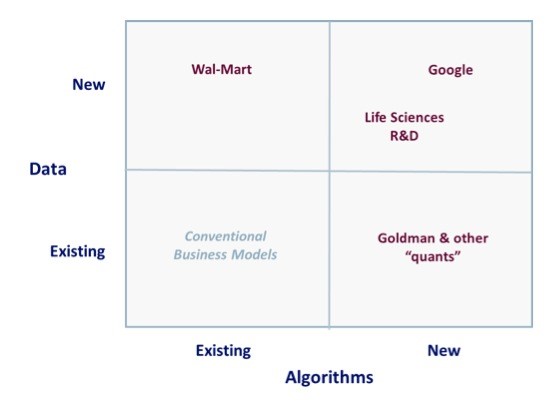“No one cares about technology for technology’s sake,” writes Howard Baldwin, Forbes‘ community editor for Data Driven Business. “Well, probably some deep-drive gearheads do, but no CIO is going to get a board to finance a huge technology purchase without some clear use case.” [“Big Data Taking Industries by Storm,” Forbes, 28 October 2014] As his headline notes, Baldwin is not writing about just any technology but about technologies that support Big Data analytics. Admittedly, there has been a lot of hype about Big Data and its value over the past several years. There has even been talk about a Big Data bubble. For example, Naomi Moneypenny (@nmoneypenny), CTO at Synxi, writes, “After riding the roller coaster of hype, Big Data disillusionment has been setting in, driven in part by the inherent fuzziness of exactly what the term means, but also because the term by itself is really descriptive of just a bunch of bits, rather than tangible business benefits.” [“Big Data as a Disrupter – Thinking About Big Data Strategically,” CMS Wire, 15 October 2014] Baldwin, however, believes the Big Data train has left the station and most industries seem to be on board. He explains:
“That’s why it’s so gratifying to see the uptake of big data across the industry spectrum. It’s not just the survey results that columnist Louis Columbus talked about, … in which 84% of enterprises see big data changing their industries in the next year. Or the results Mike Wheatley recently noted in his Silicon Angle blog, based on a joint Accenture/General Electric looking at the so-called ‘industrial Internet.’ In the latter, 66% of executives believe that there’s ‘an urgent need to adopt big data technologies to avoid losing their market position.’ But the uptake isn’t limited to industrialized or retail enterprises. We’re talking public sector, fashion, and even television.”
Baldwin and Moneypenny aren’t at odds in their views. Both agree that a strong business case needs to be made for adopting any technology, including Big Data analytics. To try and bring some luster back to the discussion of Big Data analytics, Moneypenny insists that the subject should always be placed in context. The context that matters most is business strategy. “Business strategy,” she writes, “is the context that matters to the senior executives who have the financial wherewithal to really make big things happen with big data.” She believes that when Big Data analytics are explained in context people begin to understand why they can be a disruptive force on the business landscape. To help her explain why context matters, Moneypenny uses a simple, but powerful, two-by-two model.
“The dimensions of this model result from two basic questions relating to the big data itself and the algorithms that are applied to derive actionable insights from the data:
- is the data newly available or is it existing data, and
- are the algorithms applied to the data newly invented or are they existing?
Those two simple questions form the basis for our big data-as-a-disrupter model:”
Moneypenny goes on to discuss how several companies have successfully used Big Data analytics to impact their industries. She then places those examples within her two-by-two framework (see below). She continues:
“We can draw several important conclusions about the big data-as-a-disrupter model from these cases:
- The model can potentially apply to just about any industry
- The market value of just these handful of examples alone suggest big data-as-a-disrupter may be the most successful, but under recognized, business approach of the past decade
- The model clearly extends beyond individual businesses — it can have disruptive effects on entire industries”

Baldwin adds, “The potential for eliminating waste, returns, and inefficiency in a number of industries — simply by getting insight into what’s happening and analyzing it more-granularly — makes the potential for big data really exciting.” The United States Chamber of Commerce (USCoC) also sees big benefits flowing from the analysis of Big Data. “The economic impact of big data will take a number of forms,” it writes. “A recent McKinsey report estimates that improved use of data could generate $3 trillion in additional value each year in seven industries. Of this, $1.3 trillion would benefit the United States.” [“Big Data Means Big Opportunities for Consumers, Businesses.” National Journal, 6 October 2014] The article continues, “Unlocking all that value requires the stakeholders — governments, NGOs, entrepreneurs or existing industries — to adopt new rules and procedures, the right attitude and, importantly, the right Open Data Platforms.” The article then takes a tour d’horizon of future business landscape to show how Big Data analytics can benefit a number of different commercial and public sectors.
Education
The Chamber of Commerce article states, “Using open data in education could enable approximately $890 billion to $1.2 trillion in value annually. The largest potential benefit comes from using open data to improve instruction by identifying the most effective strategies and tools for teaching specific skills and knowledge; students who acquire higher skills can expect higher lifetime earnings. Open performance data can also be used by students and parents to make more informed decisions about choices of schools and academic or vocational concentrations.” Although there have been a lot of concerns expressed about privacy in connection with education and Big Data, the potential to help students and teachers is tremendous. We constantly read arguments about the importance of class size and personal attention given to students. Big Data can help personalize education in a way that it has never been possible before.
Transportation
The USCoC article asserts, “Up to $920 billion a year could be generated per year, largely by individuals using Open Data to save time and energy in transit. The greatest potential source of value is increased productivity and time saving for individuals from using open data to reduce travel times. Additional value can be gained by using open data to improve the efficiency of public transportation and freight operations, through adjusting train and bus schedules to better match demand and optimizing operations based on industry-wide benchmarks. Open data can also inform infrastructure investments. To capture much of the consumer value of open data in transportation, consumers will need access to easy-to-use applications that provide real-time location and estimated travel times of different transportation options.” Large logistics companies like UPS and FedEx have been using Big Data analytics to help them plan their routes in order to save both time and resources. As the world becomes more urbanized, improving public transit becomes an imperative. Urbanites are becoming more tech savvy and, as a result, are generating more data that can be used to help themselves and public transit operators become more efficient. Moving people and goods efficiently around an urban environment is one the primary goals of smart city initiatives.
Health Care
The USCoC article states, “Up to $450 billion could be unlocked in the United States alone by using Open Data to help people take a more active role in disease prevention and treatment. Potential sources of value include enabling people to take an active role in disease prevention and treatment; helping providers determine what is the most timely, appropriate treatment for each patient; matching patients with the most appropriate providers; ensuring the cost-effectiveness of care; and identifying new therapies and approaches to delivering care.” Health care costs remain a concern for businesses, governments, and consumers alike. Big Data has the potential to help reduce costs and improve health care. In addition, Big Data also has the potential to help discover new drugs as well as new treatments. However, privacy concerns and potential misuse of data could derail efforts to use Big Data to improve health care.
Energy
The article asserts, “Data could improve both sides of the energy equation. On the demand side, by analyzing energy use patterns, algorithms can improve energy efficiency. For example, Tesco, a grocery store chain in Ireland and the United Kingdom, expects to save €20 million by optimizing the performance of its refrigerators. Such uses of open data could produce $180 billion to $310 billion annually in value, according to McKinsey. On the energy supply side, energy analyst Mark Mills writes, ‘At the core of the hydrocarbon revolution we find 3D seismic maps that let you know where to drill, and down-hole sensors that tell you where to steer the drill underground.’ As sensors collect more data and computing power follows Moore’s Law, more American energy will be economically feasible to produce.” Smart grids are on almost everyone’s list of “must have’s” for the future. Economic growth is powered by energy and energy demands grow as populations increase. Since most future growth will be found in urban areas, everything from smart meters to smart appliances will be needed to help meet future demands.
Consumer Finance
In her article, Moneypenny noted, “Goldman Sachs and … the quant boutiques more effectively applied sophisticated algorithms to wring every bit of possible predictive insight out of the data available. They are typically exploiting market data that is available to everyone else, they just have superior models and algorithms that are applied to the data.” The Chamber of Commerce article adds, “In banking, insurance and real estate, an estimated $210 billion or more can be captured by using Open Data to improve product design and underwriting. In particular, McKinsey said, Open Data can be used to assess risks for consumers who don’t have credit histories. It also could be used to help in fraud prevention and detection.”
International Trade
The final area discussed by the Chamber of Commerce is international trade. It writes, “Data flows are the fastest growing component of international trade. Another McKinsey report found that global flows of trade, finance, people, and data increased world GDP between $250 billion and $450 billion each year. This report also found that economies with more international connections received up to 40% more benefit than less connected economies.” Globalization relies on flows. Traditionally those flows have involved people, resources, and capital. The World Economic Forum now considers data a resource just like oil or gold. Keeping those flows going is important for both the developed and developing world. The World Bank recently reported that global percentage of people living in poverty fell from 36% in 1990 to 15% in 2011. Globalization is largely responsible for that result.
Conclusions
It should be clear from the above discussion that nearly every commercial and public sector is going to be transformed through the analysis of Big Data. Moneypenny concludes, “The big data-as-a-disrupter business model has clearly formed the basis for some of the biggest business winners of the last 10 years. Yet we’ve barely scratched the surface — tremendous sources of data lay untapped and some of the most powerful analytic approaches have only recently been developed. The race is on: be the first-mover in unleashing the disruptive force of big data in your marketplace.”




